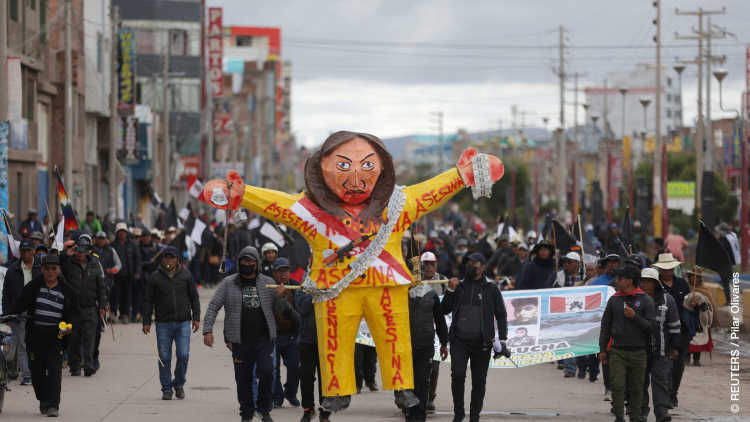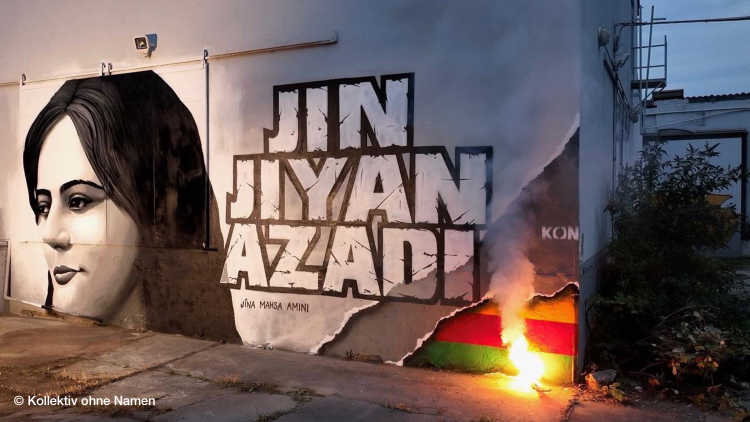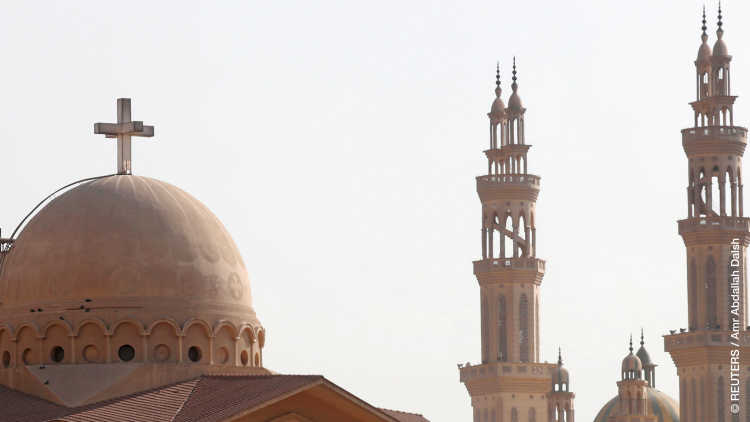- Home
- Publications
- GIGA Focus
- Development, Peacebuilding, and Women’s Agency in Northeast India
GIGA Focus Asia
Development, Peacebuilding, and Women’s Agency in Northeast India
Number 5 | 2024 | ISSN: 1862-359X

Northeast India is geopolitically significant in the Bay of Bengal area as it serves as a connecting link between India, Myanmar, and other Southeast Asian countries. India’s economic, social, and cultural connectivity with its Asian neighbours is dependent on the political stability, infrastructure, and economic development of the Northeastern region, which is prone to ethnic conflicts.
India’s Act East policy aims to promote economic cooperation, cultural ties, and strategic relationships with the extended neighbourhood in the Indo-Pacific region via continuous involvement at the bilateral, regional, and multilateral levels. Through its commitment to the Bay of Bengal Initiative for Multi-Sectoral Technical and Economic Cooperation (BIMSTEC), India aims to strengthen its social and economic linkages with Asia.
The success of these initiatives depends on the political stability in India’s Northeast and its neighbouring countries. The political conflict in Myanmar has created hurdles for projects linking India to Southeast Asia. Internally, the protracted armed and ethnic conflicts in Northeast India have deterred infrastructural and economic development.
While peace accords and ceasefires have helped manage the internal conflicts in Northeast India to an extent, they have failed to achieve durable peace in the ethnically diverse region.
Leveraging the capacities of local actors in the peace processes, especially women, many of whom have considerable experience in peacebuilding at the grassroots, can help achieve the goal of durable peace.
Policy Implications
Northeast India is geopolitically and economically crucial for India’s Act East policy. The European Union needs to factor in the complex interplay of peace, development, and gender in Northeast India while stepping up bilateral engagements with India. European development agencies should promote human rights and address gender-specific issues for overall development and durable peace.
Geopolitical Significance of Northeast India
Northeast India comprises the states of Assam, Arunachal Pradesh, Meghalaya, Manipur, Mizoram, Nagaland, Tripura, and Sikkim. Some of the ethnic groups in Northeast India are Nagas, Mizos, Kukis, Bodos, Deoris, Tripuris, Khasis, Garos, Adis, and Apatanis, among others. The region shares its borders with Myanmar, Bangladesh, Bhutan, China, and Nepal, making its location quite strategic in India’s grand vision for wider regional engagements. However, decades-long armed and ethnic conflicts have hindered peace and political stability in the region.
Figure 1. Northeast India and Its International Borders

Source: Ministry of Development of North Eastern Region (n.d.).
Peace and development are crucial for ethnically diverse Northeast India, as the region is key for India’s Act East policy. The Act East policy, with ASEAN at its core, aims to promote economic cooperation, cultural ties, and strategic relationships with the extended neighbourhood in the Indo-Pacific region through continuous involvement at the bilateral, regional, and multilateral levels. As a part of its Act East policy, India has established connections with Myanmar via important projects such as the Kaladan Multi-Modal Transit Transport Project (KMTTP) and the India–Myanmar–Thailand Trilateral Highway (IMT-TH). KMTTP links Kolkata port in India to Sittwe port in Rakhine State of Myanmar via the Bay of Bengal and to Mizoram in Northeast India. The IMT-TH, which links Moreh in India’s Manipur with Myanmar and Mae Sot in Thailand, promises to enhance India’s social, economic, and political linkages with Southeast Asia. However, the ethnic conflict in Manipur and the political conflict in Myanmar have impeded the completion of these projects.
India is also committed to the Bay of Bengal Initiative for Multi-Sectoral Technical and Economic Cooperation (BIMSTEC), whose member countries comprise India, Bhutan, Bangladesh, Myanmar, Thailand, Nepal, and Sri Lanka. Through its linkages to BIMSTEC, India aims to develop multilateral ties with the Asian region to intensify social and economic linkages. BIMSTEC members also plan to implement dispute-resolution mechanisms intended to help resolve conflicts between and within member nations. Therefore, BIMSTEC may help Northeast India resolve its protracted conflicts and usher in political stability.
Armed and Ethnic Conflicts
In Northeast India, secessionist politics and ethnic conflicts arose post-1947 – that is, after India achieved independence. Many insurgent groups with demands for separate or autonomous homelands have emerged since then. Examples are the National Socialist Council of Nagaland Isak-Muivah (NSCN-IM) in Nagaland, the United National Liberation Front (UNLF) in Manipur, and the United Liberation Front of Assam (ULFA) in Assam, as well as the National Democratic Front of Bodoland (NDFB) and the Bodo Liberation Tigers (BLT) in Bodoland, Assam, among others. Counterinsurgency operations have involved heavy militarisation and imposition of the controversial Armed Forces (Special Powers) Act of 1958.
Aside from armed insurgencies, internecine killings have taken place between different ethnic groups. Examples are the clashes between Kukis and Nagas in 1992, Meiteis and Pangals in 1993, Garos and Rabhas in 2010, Bodos and Adivasis in 1998 and 2014, and so on. The ethnic violence in India’s Northeast exhibits variations in terms of the patterns of violence, ideology, networks, and state interventions that shape the outcomes of the conflicts. Issues sparking the conflicts include “integration without consent,” “cultural nationalism,” “illegal migration,” among others (Rajagopalan 2008: ix).
However, as the Northeast is a peripheral region, the disturbances rarely garner media attention, as evident during the ethnic conflict in Manipur that erupted in May 2023. The conflict involved the valley-dwelling Hindu Meitei community and the hill-dwelling Christian Kuki community. The tensions between the two communities reportedly ensued when in April 2023 the Manipur High Court directed the Manipur government to submit its recommendation for granting Scheduled Tribe (ST) status to the Meitei community. The Kuki community, which holds ST status, argued that granting ST status to the Meitei community would increase their dominance in the government and over economic resources and allow them to acquire land in the hill areas.
As per news reports, another issue that fuelled the ethnic conflict was the influx of Chin refugees from Myanmar. Following the Myanmar coup in 2021, thousands of refugees entered India, especially Manipur and Mizoram. Since the Chin people of Myanmar share an ethnic lineage with the Kukis of Manipur, the Meiteis feared that they would be outnumbered and reduced to a minority (Kaushik and Rajesh 2023). Perceiving a threat to the Indigenous population of Manipur, the Manipur government evicted people from forest areas and led an identification and deportation drive of illegal immigrants. The chief minister of Manipur also held the Chin immigrants responsible for the 2023 conflict. The Kukis of Manipur interpreted these narratives as targeting the Kuki community and claimed that the actions of the Manipur government were biased against the Kuki community. In this way, the Manipur conflict has exposed the deep-rooted ethnic fault lines in Manipur.
Hundreds of people have been killed and thousands displaced in Manipur since May 2023. The media did not cover the news adequately, and the government of India was silent on the issue, with prominent leaders at the centre even delaying their visits to Manipur.
Peace and Development
Since the 1960s the government of India has adopted a top-down peacebuilding approach to manage the conflicts in Northeast India, prioritising negotiations, ceasefires, and rehabilitation packages vis-à-vis insurgent groups. When the fighting between Indian security forces and Naga rebels continued in the newly formed Nagaland state in 1963, the Nagaland Baptist Church Council initiated a Peace Mission with support from the government of India. The Peace Mission was successful in persuading Naga rebel leaders to sign a ceasefire in 1964. However, the violence resumed after a few years. Another ceasefire agreement signed between the government of India and the NSCN-IM in 1997 stopped the fighting between the Indian security forces and the rebels, but inter-factional killings continued. In Assam, peace accords were signed between Bodo leaders, rebel groups, the Assam government, and the central government in 1993 and 2003. However, these peace accords failed to bring about durable peace, and inter-factional fights and ethnic conflicts continued in Bodoland.
Since protracted conflicts are hindering peace and development in Northeast India and jeopardising the objectives of economic and cultural engagement with the Asian region, the Bharatiya Janata Party (BJP)-led government directed its attention towards Northeast India after coming to power in 2014. It revamped the Look East policy as the Act East policy and hastened the peace negotiations with insurgent groups. Several peace accords and agreements have subsequently been signed between the central government, state governments, and insurgent groups including but not limited to the NSCN-IM, NDFB, and the pro-talk faction of the ULFA. As per the Ministry of Home Affairs North East Division, insurgencies, civilian deaths, and casualties among security forces have reduced drastically since 2014 (with reference to latest data from 2023).
Prior to 2014, the BJP held little power in Northeast India. When Narendra Modi became prime minister, he sought to bring the non-Hindu population of Northeast India into the fold of the nationalist party. Although a ministry dedicated to the region – the Ministry of Development of North Eastern Region (DoNER) – had already existed, the BJP-led government steered it forward by allocating substantial funds for various projects. With the BJP coming to power, the Sangh Parivar – a cluster of Hindu nationalist groups such as the Rashtriya Swayamsevak Sangh (RSS) and its affiliate Vishwa Hindu Parishad (VHP) – and business groups favoured by the BJP made inroads into Northeast India (Nehal 2022). Previously, the RSS had not been able to establish itself in the region because of the significant tribal and Christian population. However, through various socio-cultural activities and the support of the BJP, in the past few years the RSS has reportedly managed to pave its way into the Northeastern states ruled by the BJP and its allied parties.
Alongside the Hindu nationalist groups, entrepreneurs such as Baba Ramdev who promote Hindutva ideologies have anchored themselves in Northeast India. Baba Ramdev’s entry into the region, especially into Christian-majority Nagaland, can be perceived as an attempt to include the peripheral region into the idea of India (Longkumer 2018). The land required for setting up projects by Baba Ramdev’s company Patanjali in Nagaland, Assam, and other parts of India is donated by villagers and the state governments (Longkumer 2018). The promise of the BJP and its allied parties in these states is that such endeavours will create jobs for the youth.
Although the BJP may have succeeded in striking a chord with the local population in Northeast India with promises of jobs and economic development, it has not succeeded in bringing long-term peace to the region. In 2015, the Framework Agreement (the Naga Peace Accord) was signed between the government of India and the NSCN-IM. However, the parties could not come to an agreement because of the NSCN-IM’s demand for a separate flag and a constitution. The BJP-led centre has rejected this demand, and the peace talks have been stalled since 2019, highlighting the failure of the government to reach an agreement with the frontier region. Moreover, the 2023 ethnic conflict between Meiteis and Kukis in Manipur indicates that although the BJP may have bridged the barrier with the Northeastern frontier through infrastructure development, its divisive politics has created deep fractures among the local population (Sitlhou 2024).
The Manipur conflict also brought the question of women to the fore. Women in Manipur have had a long history of resistance. They led the Nupi Lan (Women’s War) in 1904 and 1939 against the indiscriminate policies of the colonial government. The Meira Paibis (Women Torchbearers) of the Meitei community in Manipur led the Nishabandi movement against alcoholism in the 1970s and the resistance against the Armed Forces (Special Powers) Act in the 1990s and 2000s. Activist Irom Sharmila undertook a fast for 16 years, from 2000 to 2016, demanding the repeal of the Act.
However, during the 2023 ethnic conflict in Manipur, the Meira Paibis entered the limelight for shielding Meitei militants from the security forces and abetting violence against Kuki women (Sharma 2023). On 3 May 2023, a mob of men paraded two Kuki women naked and sexually assaulted them in the Kangpokpi district of Manipur. Arrests were made after video of the incident surfaced in July 2023. As per media reports, an investigation by the Central Bureau of Investigation revealed a year later that the two Kuki women and male members of their family had approached a police van for help, but the police had refused to help and left the women to whims of the mob.
Nonetheless, there were news reports of Kuki women displaying humanity by forming a human chain to impede Kuki men from attacking Meitei families. In June 2023 hundreds of Meitei women held a torchlight vigil in Imphal in response to the violence in Manipur.
Women as Agents of Peace in Northeast India
Women in Northeast India have been active agents of peace. As the Indian government has dealt with insurgencies in the region with heavy militarisation, women have been caught between the security forces and armed insurgents. The imposition of the draconian Armed Forces (Special Powers) Act, 1958, adversely impacted women. Security forces used rape as a political weapon against women in Northeast India during the peak of conflicts between the security forces and armed insurgents. For example, during a raid in 1988 the security forces raped 12 Bodo women in Bhumka village, Kokrajhar, and in 2004 security forces raped and brutally murdered a 32-year-old woman called Thangjom Manorama Devi in Imphal, Manipur. Following the incident, the Meira Paibis staged the historic naked protest in front of the headquarters of the 17th Assam Rifles in Kangla Fort, Manipur, holding a banner that read “Indian Army Rape Us.” In Northeast India, the security forces enjoy impunity under the Armed Forces (Special Powers) Act, 1958, and are not adequately punished for the heinous crimes committed against civilians.
In Nagaland, the Naga Mothers’ Association (NMA) negotiated between different insurgent groups and between the government and insurgent groups to bring peace. When armed conflicts intensified in the 1990s, the NMA constituted a peace committee, adopting the slogan “Shed no more blood” to broker peace between the conflicting factions. During the fratricidal killings between different Naga insurgent groups in the 2000s, fear gripped Naga society, and nobody stepped forward to claim the bodies of the slain Naga men. In such times, NMA members covered the bodies in traditional Naga shawls, as per custom. The NMA facilitated talks between different factions and intervened to stop the fratricidal killings. On several occasions, they crossed over to Myanmar by undertaking an arduous trek across rivers and through jungles to negotiate with armed groups camped in Myanmar. Following the NMA’s visit, the armed groups agreed to take part in negotiations.
In Assam, the All Bodo Women’s Welfare Federation (ABWWF) appealed for peace between the Bodo insurgent groups. The ABWWF, along with the Bodo Women’s Justice Forum, another women’s organisation, engaged in face-to-face dialogues with members of the BLT and NDFB and urged them to stop the fratricidal killings. The members of the ABWWF organised peace rallies and protest marches against the atrocities of the security forces on Bodo people during the Bodoland movement.
However, despite their significant contributions to peacebuilding, women in Northeast India have been excluded by the government and local elites from formal peace processes. In Northeast India, peace accords have become state-induced ways of managing a set of conflict actors while silencing the voices of the marginalised groups. Further, ceasefires and peace accords have created intra-group divisions and reduced the prospects for constructive peace that is gender-sensitive and inclusive of women or other marginalised groups as active agents of peace.
Challenges to Women’s Participation in Electoral Politics
One reason why women are excluded from formal peace processes is the inconsistent approach of India – as a non-permanent member of the United Nations Security Council – towards UNSC Resolution (UNSCR) 1325 on women, peace, and security (WPS). While India supports the WPS agenda by sending female peacekeepers on UN peacekeeping missions, it has rarely prioritised including women in conflict mediation, resolution, and prevention in formal peace talks at home (Seth 2022), as UNSCR 1325 also emphasises. In late 2023 at the United Nations Security Council, India’s deputy permanent UN representative, Yojna Patel, underlined the crucial role of women in social change and cohesion. Patel especially highlighted that the Women’s Reservation Bill, which was passed by the Indian Parliament in September 2023, will empower Indian women to participate in decision-making at all levels (The Times of India 2023).
One of the major reasons for women’s low representation in decision-making roles in India has been the many challenges to their participation in electoral politics. Gender, class, caste, and patriarchal constraints encumber women’s participation in electoral politics (EPW Engage 2024). As per the Global Gender Gap Report 2023, women constitute 15.1 per cent of the members of Parliament in India (EPW Engage 2024). The percentage of women in Parliament is likely to increase in the future with the Women’s Reservation Bill (Nari Shakti Vandan Adhiniyam). As per the bill, one third of the seats of the Lok Sabha, the Legislative Assembly of Delhi, and state assemblies must be reserved for women. While the bill’s passage is a big win for women, the celebrations must wait, because it will go into effect only after the delimitation exercise is completed following the 2025 Census. The delimitation exercise is the process of demarcating the boundaries of constituencies and fixing the number of seats in each state in India for the Lok Sabha and Legislative Assemblies. The process also determines the number of seats to be reserved for Scheduled Castes, Scheduled Tribes, and women in the Lok Sabha and Legislative Assemblies. This means that the bill will be implemented starting with the 2029 general elections.
The Women’s Reservation Bill was a major component of the BJP’s 2024 general elections manifesto, indicating that the party highlighted women’s issues to persuade women voters. As per news reports, in the 2024 elections, the BJP fielded more women candidates than any other party. After retaining power in 2019, the BJP government directed many welfare schemes towards women. Just before the 2024 elections, on International Women’s Day, the government reduced the price of liquified petroleum gas used in domestic cooking by approximately 10 per cent. Critics called the move an election gimmick, and feminist critics perceived the move as reinforcing conservative gender norms (Brechenmacher 2023).
In the Northeastern states, political parties have fielded very few women to date, and even fewer have won. However, the 2023 Assembly elections in Northeast India saw some marked improvement as women won seats across different states. Two women were elected to the 60-member Nagaland Legislative Assembly for the first time since state formation in 1963. Three women were elected to the 60-member Meghalaya Legislative Assembly, and another three were elected to the 40-member Mizoram Legislative Assembly. Tripura fared better than the other states, as eight women were elected to the 60-member Tripura Legislative Assembly.
In Northeast India, women are continuously struggling for their socioeconomic and political rights because they are frequently disadvantaged within their own ethnic groups (Banerjee and Dey 2012). For example, the Naga customary laws hindered women’s participation in electoral politics. The customary laws differ across the tribes and villages in Nagaland and are passed down orally from generation to generation. In 2017 the patriarchal and discriminatory nature of the customary laws translated into formal politics when protests erupted in Dimapur, Nagaland, over a 33 per cent reservation for women in the Urban Local Body (ULB) elections. In 1992 the 73rd and 74th Amendment Acts of the Constitution of India mandated the reservation of one third of seats in Panchayat Raj Institutions and ULBs, respectively, for women. The amendments improved women’s representation in local self-governance. However, the Nagaland government delayed implementing the 74th Amendment Act by several years. Tribal Bodies in Nagaland opposed the 33 per cent reservation for women on the grounds that providing reservation to women would defeat the purpose of customary laws being protected under Article 371(A) of the Indian Constitution (Hausing 2017). Naga women countered the claim by stating that ULB elections are outside the purview of customary laws. After a prolonged legal battle, and after the Women’s Reservation Bill was passed by the Parliament in September 2023, the Nagaland Legislative Assembly passed the bill retaining 33 per cent reservation for Naga women in the ULBs in November 2023.
The exclusion of women from formal peace processes in Northeast India may be attributed to their underrepresentation in formal politics, which is dominated by men. Women are typically stereotyped as victims of conflict. While women’s endeavours in peacebuilding are continuous, the responses from the mediators and interlocuters of the government are erratic. Further, the formal peace processes and conflict-management approaches undertaken by the government lack gender perspectives (Kolås 2017). In addition, since women do not hold important positions either on the side of the government or on the side of the insurgent groups, they are rarely included at the negotiating table. Although the government of India consulted civil society groups, including the NMA, in the initial phases of the Naga peace talks, the consultations stopped after the Naga peace talks hit a roadblock.
In Northeast India, women rarely occupy decision-making roles. Education and modernisation do not necessarily translate into women’s empowerment and their increased participation in decision-making. Men constitute the majority in political institutions vested with the power to pass resolutions, including those concerning women (Hausing 2017). Hence, the decisions are not always in favour of women. In this regard, quotas for women’s electoral participation at the national, regional, and local levels will increase the number of women in political institutions and, therefore, in decision-making.
The Way Forward
Being a geopolitically significant region for India’s Act East policy and BIMSTEC, Northeast India has gained considerable importance in recent years. Countries such as Japan have invested in infrastructure development in the region. The Japan International Cooperation Agency and the Asian Development Bank are financing and investing in several road construction projects in Northeast India; it is believed that the improved connectivity will foster economic ties with neighbouring countries. Connectivity projects between India, Myanmar, and Thailand are also underway. Furthermore, India’s Frontier Highway Project in Arunachal Pradesh is expected to facilitate the movement of defence forces and supplies to the Indo-China border.
While infrastructural and economic development alike are essential for the underdeveloped Northeastern region, durable peace is imperative for realising the fruits of development. Peace accords are top-down instruments that manage conflicts rather than resolve or transform them. Moreover, peace accords satisfy only a particular set of conflict actors while ignoring many important local actors such as civil society groups, women’s groups, and students’ groups. In the context of Northeast India, women have acted as important local agents of peacebuilding. Hence, they must be economically and politically empowered and included in decision-making processes, including peace processes. European development agencies should promote aid and address human rights and gender-specific issues in their bilateral initiatives. For instance, in its bilateral relations with India, Germany has included a component of development cooperation under which it
supports the economic participation of women [and] the setting up of a practice-oriented vocational training system and provides stimulus for innovative approaches, e.g. by promoting start-ups. (German Federal Foreign Office 2024)
Such initiatives can lead to all-encompassing development in Northeast India and durable peace. Durable peace, in turn, can optimise the potential for India to enhance its political, social, economic, and cultural cooperation with Asia and the extended neighbourhood in the Indo-Pacific region.
Footnotes
References
Banerjee, Paula, and Ishita Dey (2012), Women, Conflict, and Governance in Nagaland, Policies and Practices 51, Mahanirban Calcutta Research Group.
Brechenmacher, Saskia (2023), India’s New Gender Quota Law Is a Win for Women – Mostly, 26 September, Carnegie Endowment for International Peace, accessed 26 May 2024.
EPW Engage (2024), Women’s Reservation Act of 2023: A Symbolic Gesture or a Significant Stride Towards Empowerment?, 20 March, accessed 26 May 2024.
German Federal Foreign Office (2024), Germany and India: Bilateral Relations, 5 March, accessed 2 June 2024.
Hausing, Kham Khan Suan (2017), ‘Equality as Tradition’ and Women’s Reservation in Nagaland, in: Economic & Political Weekly, LII, 45, 36–43.
Kaushik, Krishn, and Y. P. Rajesh (2023), Manipur: Ethnic Violence in the Indian State Explained, in: Reuters, 21 July, accessed 28 May 2024.
Kolås, Åshild (2017), Women Peace and Security in Northeast India, New Delhi: Zubaan.
Longkumer, Arkotong (2018), ‘Nagas Can’t Sit Lotus Style’: Baba Ramdev, Patanjali, and Neo-Hindutva, in: Contemporary South Asia, 26, 4, 400–420.
Ministry of Development of North Eastern Region (n.d.), About North East, accessed 27 May 2024.
Nehal, Ashraf (2022), How the RSS Has Been Making Inroads Into the Northeast and Kerala, in: The Wire, 30 September, accessed 27 May 2024.
Rajagopalan, Swarna (2008), Peace Accords in Northeast India: Journey Over Milestones, Policy Studies 46, Washington, DC: East-West Center.
Seth, Shivangi (2022), India’s Inconsistent Adherence to the Women, Peace and Security Agenda, The Lowy Institute, 10 June, accessed 30 April 2024.
Sharma, Manorama (2023), Meira Paibis: How Manipur’s Peace-Keepers Became Agents Provocateur, in: Frontline, 24 August, accessed 27 May 2024.
Sitlhou, Makepeace (2024), Under Modi, the Northeast Is More United with India, but More Divided Within, in: Himal Southasian, 17 April, accessed 27 May 2024.
The Times of India (2023), Women Are Agents of Social Change and Social Cohesion: India at UNSC, 27 October, accessed 26 May 2024.
Editor GIGA Focus Asia
Editorial Department GIGA Focus Asia
Regional Institutes
Research Programmes
How to cite this article
Saikia, Amrita (2024), Development, Peacebuilding, and Women’s Agency in Northeast India, GIGA Focus Asia, 5, Hamburg: German Institute for Global and Area Studies (GIGA), https://doi.org/10.57671/gfas-24052
Imprint
The GIGA Focus is an Open Access publication and can be read on the Internet and downloaded free of charge at www.giga-hamburg.de/en/publications/giga-focus. According to the conditions of the Creative-Commons license Attribution-No Derivative Works 3.0, this publication may be freely duplicated, circulated, and made accessible to the public. The particular conditions include the correct indication of the initial publication as GIGA Focus and no changes in or abbreviation of texts.
The German Institute for Global and Area Studies (GIGA) – Leibniz-Institut für Globale und Regionale Studien in Hamburg publishes the Focus series on Africa, Asia, Latin America, the Middle East and global issues. The GIGA Focus is edited and published by the GIGA. The views and opinions expressed are solely those of the authors and do not necessarily reflect those of the institute. Authors alone are responsible for the content of their articles. GIGA and the authors cannot be held liable for any errors and omissions, or for any consequences arising from the use of the information provided.

















